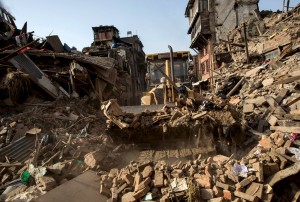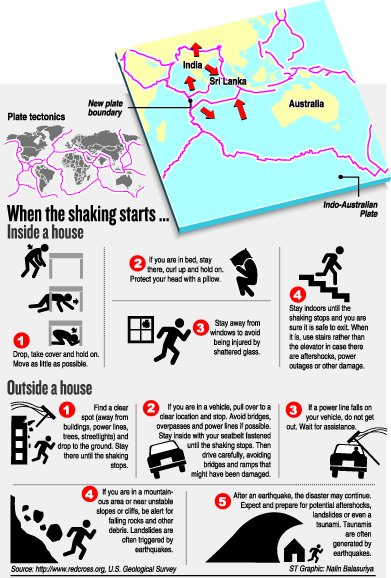News
Lanka safe from major quakes but “home” plate is splitting
Geologists claim Sri Lanka has very little chance of experiencing a major earthquake but point out the importance of preparedness given the disaster in Nepal.

A bulldozer clears debris from collapsed houses following the earthquake in Bhaktapur, Nepal. REUTERS
An earthquake usually occurs when two blocks of the earth suddenly slip past one another, hit each other or break apart as a result of tension caused by prolonged energy build-up.
Geologists believe the Earth’s outer layer consists of seven or eight major plates (and many minor plates), known as tectonic plates.
These plates move a few centimeters annually, with pressures building at the edges until suddenly that energy bursts forth.
Nepal is located at the edge of where the Indo-Australian plate meets the Eurasian plate and many geologists had warned about the possibility of a major earthquake.
Sri Lanka is in the middle of Indo-Australian tectonic plate so the country’s vulnerability for a major earthquake is lower, says L.R.K. Perera a senior lecturer at the Department of Geology at the University of Peradeniya.
Smaller earthquakes can, however, occur anywhere and most tremors don’t even register on the seismic meters, he added.
There are signs that the Indo-Australian tectonic plate is splitting but this is occurring about 500km away from Sri Lanka’s southern coast and the country might not experience a major impact, says geologist Prof. C.B. Dissanayake.
Yet the possibility of minor to medium earthquakes is significant due to this new development, and Sri Lanka’s vulnerability from such a scenario comes from the definite threat of tremor-induced landslides, Professor Dissanayake added.
The highland terrain of Sri Lanka is highly unstable and landslides can be easily triggered even with a minor tremor, he said.
The head of the Landslide Research and Risk Management Division at the National Building Research Organisation (NBRO) K.N. Bandara, said research is being carried out into soil liquefaction in different areas of the country. Liquefaction is the process of loose soil acting like a liquid during an earthquake making the buildings and structures sink into sand.
Previous research carried out by Moratuwa University’s Geo-Technical Team under the guidance of Dr. Nalin De Silva revealed the eastern region of the country has soil more vulnerable to liquefaction, making the area more vulnerable to the effects of earthquakes.
The soil in Colombo is not so that bad as the sand is mixed with other particles such as clay, Dr. de Silva said.
The Sunday TImes learned that another research team led by Moratuwa University is preparing building codes to be considered in building earthquake-resilient buildings.
The level of damage by an earthquake depends on where it happen as even a moderate earthquake can make lot of damage in a populated area where a very powerful earthquake in unpopulated area would not cause much harm.

